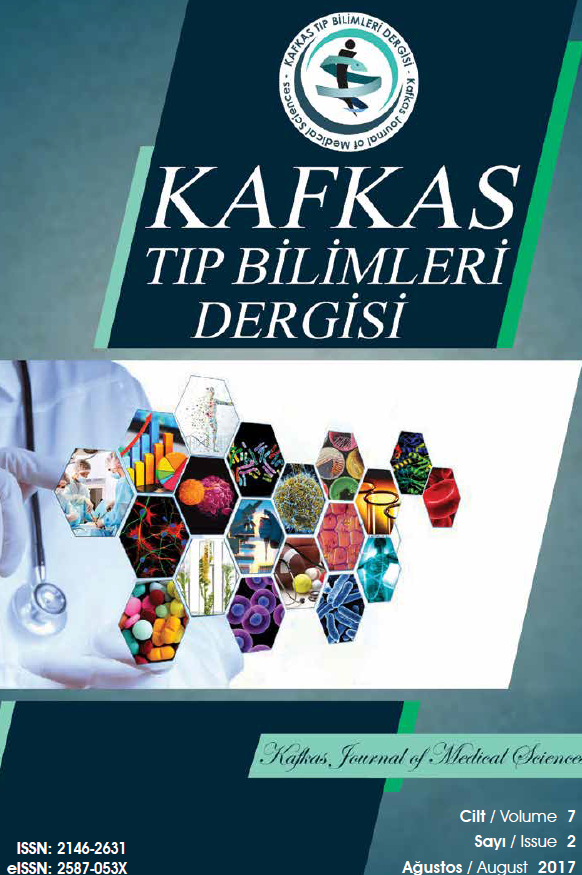The Role of Parenchymal Thickness in Predicting the Amount of Bleeding During Percutaneous Nephrolithotomy
The Role of Parenchymal Thickness in Predicting the Amount of Bleeding During Percutaneous Nephrolithotomy
percutaneous nephrolithotomy, bleeding, parenchymal thickness,
___
- 1. Urolithiasis - Guidelines - Uroweb 2022.
- 2. Labate G, Modi P, Timoney A, Cormio L, Zhang X, Louie M, et al. The percutaneous nephrolithotomy global study: classification of complications. J Endourol. 2011;25(8):1275–80.
- 3. Hosein M, Paskar D, Kodama R, Ditkofsky N. Coming together: A review of the American Association for the Surgery of Trauma’s Updated Kidney Injury Scale to facilitate multidisciplinary management. AJR Am J Roentgenol. 2019;213:1091–9.
- 4. Poudyal S. Current insights on haemorrhagic complica-tions in percutaneous nephrolithotomy ScienceDirect. Asian J Urol. 2022;9:81–93.
- 5. Kessaris DN, Bellman GC, Pardalidis NP, Smith AG. Management of hemorrhage after percutaneous renal surgery. J Urol. 1995;153(3 Pt 1):604–8.
- 6. Wollin DA, Preminger GM. Percutaneous nephrolithotomy: complications and how to deal with them. Urolithiasis. 2018;46(1):87–97.
- 7. Alabat Roca A, Torrecilla Ortíz C, Cuadrado Campaña JM, Colom Freixas S, Fernández-Concha Schwalb J, Beato García S, et al. Hemorrhagic complicationes after percutaneous nephrolithotomy: The importance of an early endovascular management. Actas Urológicas Españolas (English Edition) 2021;45(10):635–41.
- 8. Liu Y, Zhu W, Zeng G. Percutaneous nephrolithotomy with suction: is this the future? Curr Opin Urol. 2021;31(2):95101.
- 9. El-Nahas AR, Nabeeh MA, Laymon M, Sheir KZ, El-Kappany HA, Osman Y. Preoperative risk factors for complications of percutaneous nephrolithotomy. Urolithiasis. 2021;49(2):15360.
- 10. Wei C, Zhang Y, Pokhrel G, Liu X, Gan J, Yu X, et al. Research progress of percutaneous nephrolithotomy. Int Urol Nephrol. 2018;50:807–17.
- 11. Lang EK. Percutaneous nephrostolithotomy and lithotripsy: a multi-institutional survey of complications. Radiology. 1987;162(1):25–30.
- 12. Skolarikos A, De La Rosette J. Prevention and treatment of complications following percutaneous nephrolithotomy. Curr Opin Urol. 2008;18(2):229–34.
- 13. Said SHA, Al Kadum Hassan MA, Ali RHG, Aghaways I, Kakamad FH, Mohammad KQ. Percutaneous nephrolithotomy;alarming variables for postoperative bleeding. Arab J Urol. 2017;15(1):24.
- 14. Kukreja R, Desai M, Patel S, Bapat S, Desai M. Factors affecting blood loss during percutaneous nephrolithotomy: prospective study. J Endourol. 2004;18(8):715–22.
- 15. Stoller ML, Wolf JS, And JR, Lezin MAS. Estimated blood loss and transfusion rates associated with pecutaneous nephrolithotomy. J Urol. 1994;152:1977–81.
- 16. Karalar M, Tuzel E, Keles I, Okur N, Sarici H, Ates M. Effects of parenchymal thickness and stone density values on percutaneous nephrolithotomy outcomes. Med Sci Monit. 2016;22:4363–8.
- 17. Tepeler A, Binbay M, Akman T, Erbin A, Kezer C, Silay MS, et al. Parenchymal thickness: does it have an impact on outcomes of percutaneous nephrolithotomy? Urol Int. 2013;90(4):40510.
- 18. Rifaioğlu MM, Önem K, Çelik H, Davarcı M, Çetinkaya M, İnci M, et al. Does renal parenchymal thickness affect bleeding in percutaneous nephrolithotomy? Turk J Med Sci. 2013;43:878–85.
- 19. Lee JK, Kim BS, Park YK. Predictive factors for bleeding during percutaneous nephrolithotomy. Korean J Urol. 2013;54(7):448–53.
- 20. Turna B, Nazli O, Demiryoguran S, Mammadov R, Cal C. Percutaneous nephrolithotomy: variables that influence hemorrhage. Urology. 2007;69(4):603–7.
- 21. Kocan H, Ozdemir E. Independent risk factors affecting hemorrhage in percutaneous nephrolithotomy: Retrospective study. Actas Urológicas Españolas (English Edition) 2022;46(9):544–9.
- 22. Parvex P, Pippi-Salle JL, Goodyer PR. Rapid loss of renal parenchyma after acute obstruction. Pediatr Nephrol. 2001;16(12):1076–9.
- 23. Beland MD, Walle NL, Machan JT, Cronan JJ. Renal cortical thickness measured at ultrasound: is it better than renal length as an indicator of renal function in chronic kidney disease? AJR Am J Roentgenol. 2010;195(2):W146–9.
- ISSN: 2146-2631
- Yayın Aralığı: Yılda 3 Sayı
- Başlangıç: 2011
- Yayıncı: Kafkas Üniversitesi
Muammer KARAKAYALI, Timor OMAR, İnanç ARTAÇ, İbrahim RENCÜZOĞULLARI, Yavuz KARABAĞ, Şerif HAMİDEYİN, Mehmet ALTUNOVA
Elif KERVANCIOĞLU DEMİRCİ, Gülnaz KERVANCIOĞLU, Salih ÇAYIR, Eren KERVANCIOĞLU, Ertan SARIDOĞAN
Yasemen ADALİ, Kenan BİNNETOĞLU, Hatice BEŞEREN, Hasan ÇANTAY, Turgut ANUK, Tülay DİKEN ALLAHVERDİ, Barlas SÜLÜ, Doğan GÖNÜLLÜ
Methods of Coping With Psychological Pain and Stress in Antisocial Personality Disorder
Burcu SIRLIER EMİR, Sevler YILDIZ, Aslı KAZĞAN KILIÇASLAN, Şeyma SEHLİKOĞLU, Osman KURT, Kerim UĞUR
İbrahim YAĞCI, Ali İNALTEKİN, Muammer KARAKAYALI
Mehmet USLU, Ümit YILDIRIM, Mehmet EZER, İsmet Bilger ERİHAN, Bumin ÖRS
Regional Anesthesia in Ophthalmic Surgery
Ahmet ŞEN, Tuğcehan SEZER AKMAN
Vitamin D, Vitamin B12 and Ferritin Levels in Children Presenting with Malnutrition Complaints
The Effect of Glomerular Filtration Rate and Troponin on the Prognosis of Patients with COVID-19
